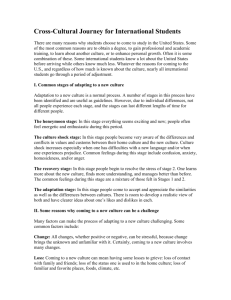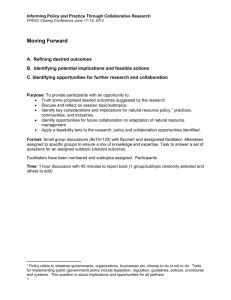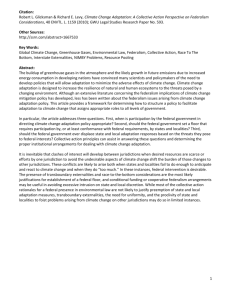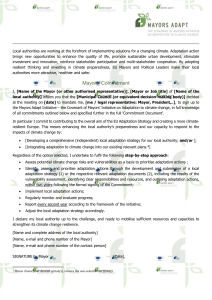Cultural Adaptation presentation - University of Illinois Springfield
advertisement
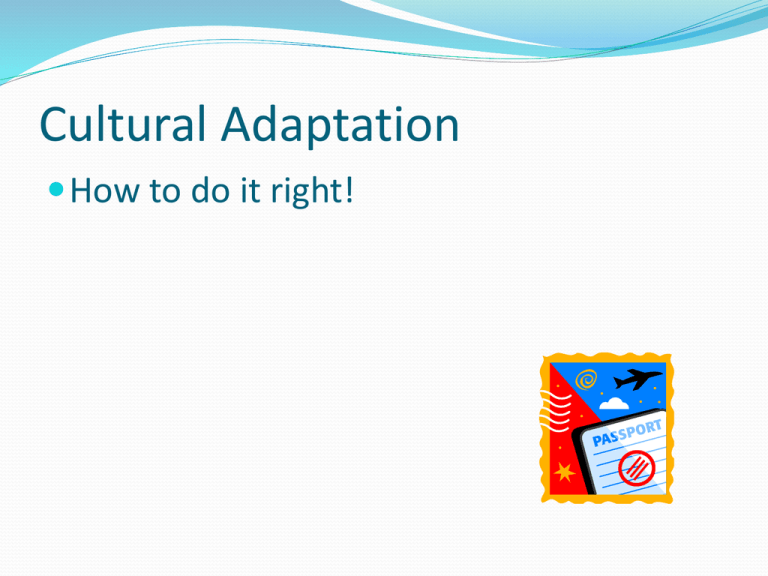
Cultural Adaptation How to do it right! It’s normal Adjusting to a new culture is a normal process – everyone must do it. Each individual experiences it a little bit differently. It produces a wide variety of reactions and feelings. It does normally follow certain stages. Not everyone experiences every stage. Even those who do experience them all may not do so in the same order, within the same time frame, or to the same degree. Stages of Cultural Adaptation The Honeymoon Stage – Let the Fun Begin Usually the first stage Experienced immediately upon arrival Everything seems exciting and new Focus is on the sense of success in being in a new culture There is a high degree of curiosity and interest in the novelty of the new surroundings There exists an appreciation for and anticipation of the opportunities to be found in the new culture Most people feel energetic, enthusiastic, and positive during this stage Stages of Cultural Adaptation The Culture Shock Stage – Ouch, This Hurts! Primary focus is on the differences between the home culture and the new culture A foreign language Uncertainty about how to interact with people in authority Unclear ideas about how to make friends with people from the new culture Doubts about how to date people from the new or other cultures Difficulty communicating in the usual way Distaste for local foods Encountering strange religious practices Discovering differences in the educational system and classroom etiquette Disappointment that people in the new culture may become impatient when you do not immediately understand things Finding that some people in the new culture are simply prejudiced against people who are not like them Stages of Cultural Adaptation The Culture Shock Stage – Ouch, this hurts! You may have conflicts with other people, or they may be internal – you may begin to struggle with your own values, habits, and preferences in the context of the new culture. You may experience feelings of Anxiety Homesickness Anger Loneliness Helplessness Fear for your safety Confusion about which values you should choose Uncertainty about whether to stay or return home Not belonging Stages of Cultural Adaptation The Recovery Stage After spending more time in the new culture, most people begin to resolve some of the conflicts that they are experiencing and to regain a sense of appreciation that they might have experienced in the first stage. They have learned more about the new culture and are able to better understand both the external and internal resources available to them. During this stage your feelings are generally a mix of those experienced in the first two stages. Stages of Cultural Adaptation The Adaptation Stage During this stage you will develop a more realistic understanding of both the similarities and the differences between your home culture and the new culture and will gain clearer ideas about what you like and dislike in each. Many people move in the direction of becoming “bicultural” – being able to value and appreciate aspects of both cultures that they wish to retain or include in their lives. This stage may be characterized by a sense of confidence, maturity, flexibility and tolerance. Stages of Cultural Adaptation Yes, there is one more – Reverse Culture Shock After you have become relatively comfortable with the new culture, and are able to learn and incorporate new attitudes and behaviors allowing you to function better in the new culture, you may return to your home culture and may discover that both you and the home culture have changed (especially if you have been gone for an extended period of time) requiring that you go through the whole process again! This can be especially confusing if you were expecting to just return home and find yourself fitting in just as before. Successful Cultural Adaptation Academic Skills Become familiar with the expectations of the U.S. academic system. Discuss educational norms with fellow students, academic advisors, and teachers. Take advantage of university-provided assistance to enhance reading and study skills. Review exams and papers after they are returned and seek to discover what was expected. Let teachers and assistants know what you need. Ask them for suggestions, ideas, and assistance. Successful Cultural Adaptation Social Skills Learn about the U.S. holidays, practices, and social customs. Spend time in conversation with students and others from the U.S. Use the media – TV, movies, music, newspapers, internet, etc. – to learn all that you can about local and national news, events, and culture. When uncertain about the appropriate behavior, language, etc. in a given situation, check with others. Find someone with whom you feel comfortable to serve as your “culture coach.” Successful Cultural Adaptation Emotional Support Everyone needs others – friends, family – to lean on during times of stress. The period of cultural adaptation can be doubly difficult because there are many new sources of stress and those we are accustomed to leaning on are either absent or experiencing their own culture shock. Find someone with whom you can share feelings and experiences. Develop a new support network. Stay in contact with friends and family back home. Balance work with recreation and fun. Seek professional support if needed. A Cultural Adaptation Diagram Introducing American Life The U.S. – a nation of immigrants No One type of national behavior One life style One culture A few general issues you are sure to encounter* *Based on Introduction to American Life, by Densow, Tinkham, and Willer. © NAFSA 2004 Time Americans are obsessed with it A valuable and scarce commodity On time = Respect; Late = Rude On time = a few minutes BEFORE the start hour Social situations more flexible Preference for One-thing-at-a-time, planned agendas Communication No interruptions, please Get to the point (time, again) Information No = no, yes = yes Clear, complete, direct Ask Look at me Why is that funny? Status / Hierarchy Accomplishments matter more than age, tradition, or family background “All people are created equal.” – courtesy expected Includes: Race Gender Ethnicity National origin Sexual orientation Status / Hierarchy Informal interaction usually preferred When in doubt, ask Informal ≠ absence of authority Observe and imitate Rule of Law: Protections/Restrictions Everyone (individually) is held accountable Even if you do not know about the law/rule Criminal laws: robbery, assault Civil laws: contracts, driving privileges Immigration regulations = privileges/benefits, not rights Especially applicable to students: legal age for alcohol consumption, driving, physical assault, contracts (rental agreements), institutional rules Relationships / Connections Casual, friendly ≠ close, lasting Segmentation: different friends for different activities Love American Style Casual dating Committed relationships Mutual Same-sex Inappropriate behaviors (physical, verbal) not tolerated Ask Community Life Shared space Respect Responsibility “Cleanliness is next to godliness” Rules apply to everyone for the benefit of everyone Individual space Privacy Ownership Quiet All the above Find a Culture Coach American Student Your age Open and honest Keep it official Enjoy the USA! This has been a presentation of the Office of International Student Services University of Illinois at Springfield One University Plaza, MS HRB 52 Springfield, IL 62703 217-206-6678 iss@uis.edu www.uis.edu/internationalstudentservices







